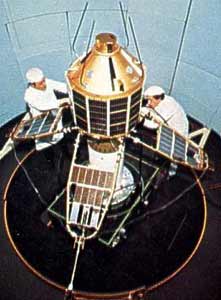Ariel 4
 Ariel 4. | |
| Mission type | Ionospheric |
|---|---|
| Operator | SERC / NASA |
| COSPAR ID | 1971-109A |
| SATCAT no. | 5675 |
| Mission duration | 1 year (design life) |
| Spacecraft properties | |
| Manufacturer | BAC |
| Launch mass | 99.5 kilograms (219 lb) |
| Start of mission | |
| Launch date | 11 December 1971, 20:47:01 UTC |
| Rocket | Scout B-1-F S183C |
| Launch site | Vandenberg SLC-5 |
| Contractor | NASA |
| End of mission | |
| Decay date | 12 December 1978 |
| Orbital parameters | |
| Reference system | Geocentric |
| Regime | Low Earth |
| Eccentricity | 0.00795 |
| Perigee altitude | 473 kilometres (294 mi) |
| Apogee altitude | 590 kilometres (370 mi) |
| Inclination | 82.9 degrees |
| Period | 95.26 minutes |
| Epoch | 10 January 1972[1] |
Ariel 4, also known as UK 4, was a British ionospheric research satellite, which was operated by the Science and Engineering Research Council. It was built by the British Aircraft Corporation,[2] and had a mass at launch of 100 kilograms (220 lb).[3] It was launched in 1971, aboard an American rocket.
The launch of Ariel 4 occurred at 20:47:01 GMT on 11 December 1971, from Space Launch Complex 5 at the Vandenberg Air Force Base. It was conducted by the United States National Aeronautics and Space Administration, using a Scout B-1 rocket.[4] Ariel 4 was placed into a Low Earth orbit, with a perigee of 473 kilometres (294 mi), an apogee of 590 kilometres (370 mi), 82.9 degrees of inclination and an orbital period of 95.3 minutes as of 10 January 1972. It decayed from orbit on 12 December 1978.[1]
See also
References
- ^ a b McDowell, Jonathan. "Satellite Catalog". Jonathan's Space Page. Retrieved 6 December 2013.
- ^ "World Civil Satellites 1957-2006". Space Security Index. Retrieved 8 September 2009.
- ^ Krebs, Gunter. "Ariel 3, 4". Gunter's Space Page. Retrieved 8 September 2009.
- ^ McDowell, Jonathan. "Launch Log". Jonathan's Space Page. Retrieved 8 September 2009.
